Content behind a paywall is available online for a subscription or a one-time fee. It may restrict users’ and search engines’ visibility and accessibility to content, posing some challenges for SEO. However, it also has benefits, such as increasing revenue, attracting more qualified leads, and improving perceived value and trustworthiness.
Are you looking to monetize your valuable content without hurting SEO rankings? Learn how to choose the right paywall model and make your website search engine-friendly.
What is Paywall?
When a publisher invests significant effort in identifying a specific need and crafting a solution as a whitepaper, ebook, or comprehensive article, they have a valid rationale for placing their specialized content behind a paywall.
The paywall is an important part of the monetization for many organizations, encouraging them to create high-quality materials. Information that should be locked behind a paywall includes content users want to read but cannot find elsewhere. For example:
- Investigations;
- Exclusive publications;
- Content that helps make important decisions (EEAT and YMYL articles);
- Reviews;
- Expert comments;
- Analysis from well-known authors.
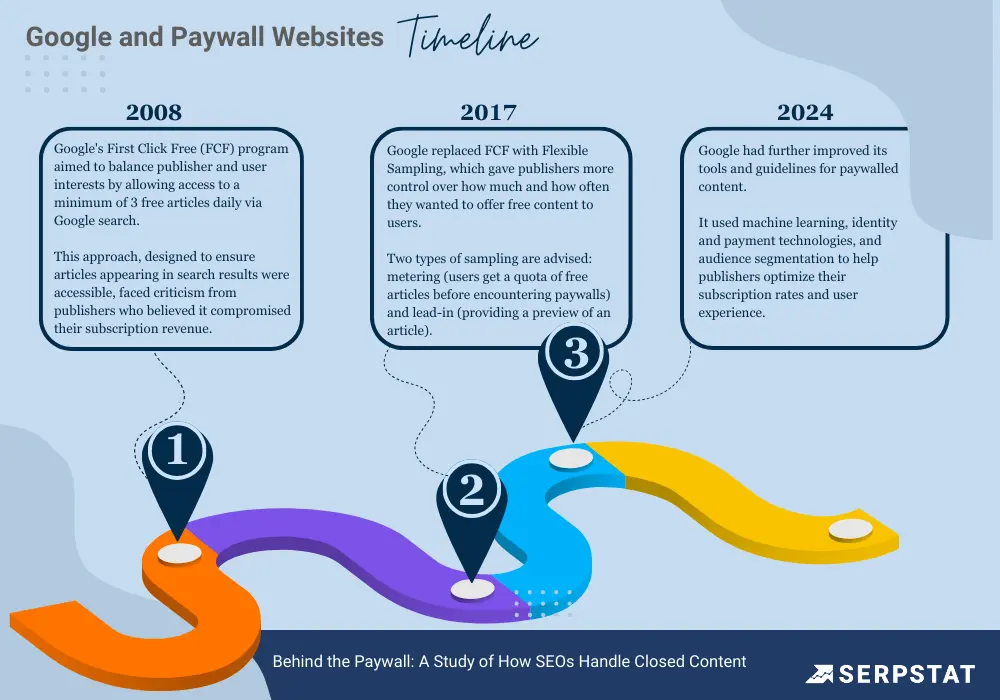
Paywall Examples
There are different types of paywalls, such as hard, metered, dynamic, or freemium, and each has advantages and disadvantages for publishers and users.
Freemium Paywall
The freemium model combines gated and ungated content, with some articles accessible without a paywall and others behind one.
An instance of the freemium paywall model can be seen in The Guardian, a UK news website. They provide three subscription tiers: supporter, partner, and patron. While users can access most news articles, premium content like crosswords, puzzles, apps, and exclusive newsletters requires a paid subscription.

If your website has a large and loyal reader base, different types of content, and exclusive content, then Freemium makes sense.
Metered paywall
Metered paywalls limit the number of articles visitors can read before asking them to subscribe. Usually, this is three articles, but it can also be five. One of the most famous metered paywalls is Medium.
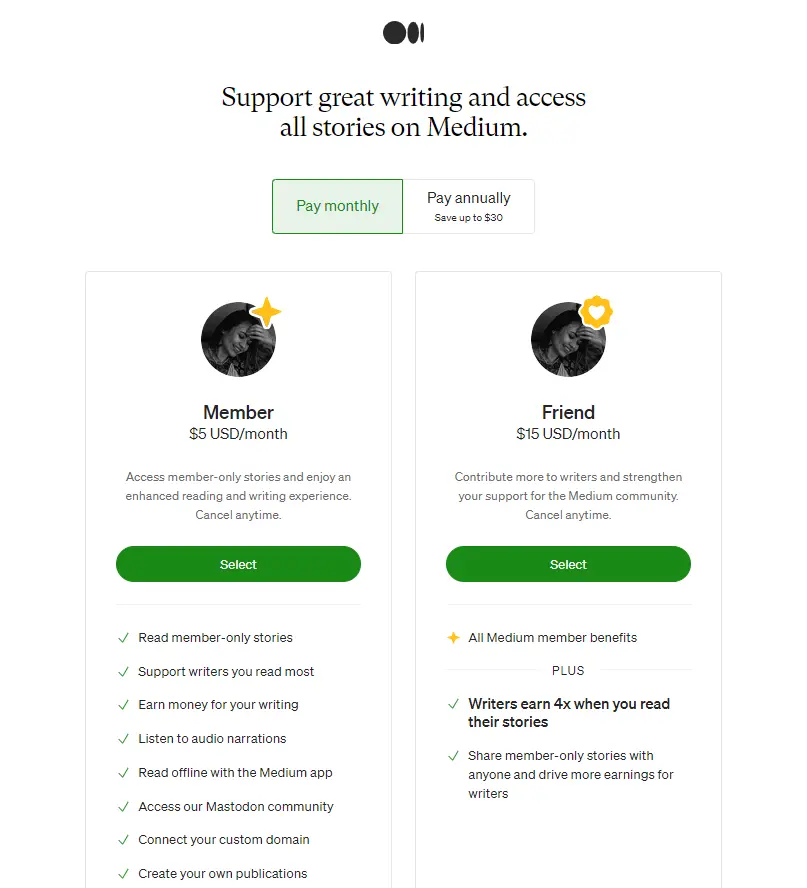
This model can benefit the media. It gives just a sample of content to make readers understand if they want more information from this source.
Users often find encountering a paywall frustrating. To mitigate this, publishers can reduce user irritation by transparently indicating the number of articles available for access in a specific period, tracking and displaying the remaining articles a user can view, and clearly explaining how to access additional content.
Dynamic paywall
Paywalls that adjust to each individual’s behavior and preferences are known as dynamic paywalls. Usually, the dynamic paywall strategy is optimized for two metrics: reader engagement and paywall subscriptions.
An excellent example of the dynamic model in B2C is the New York Tymes (NYT), media which used to start with a metered model:
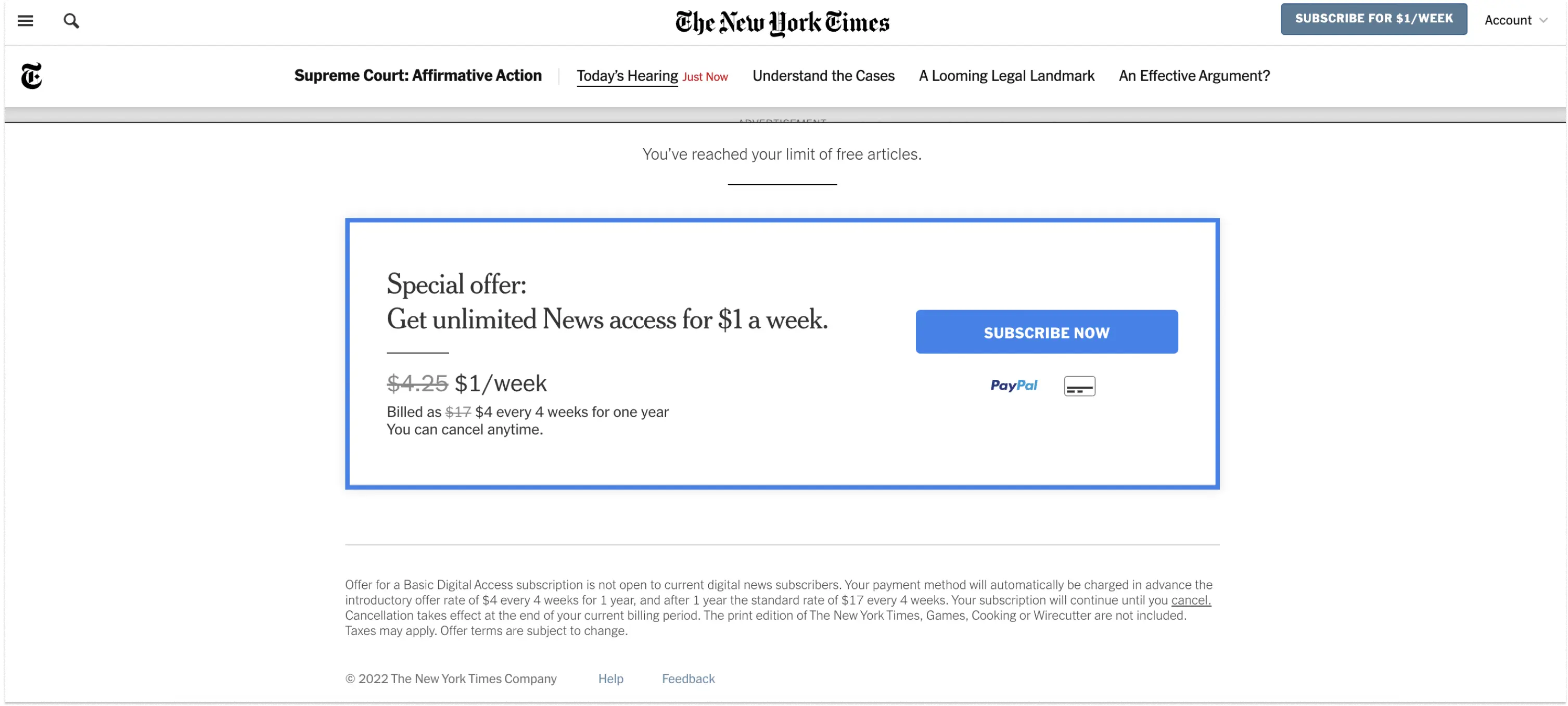
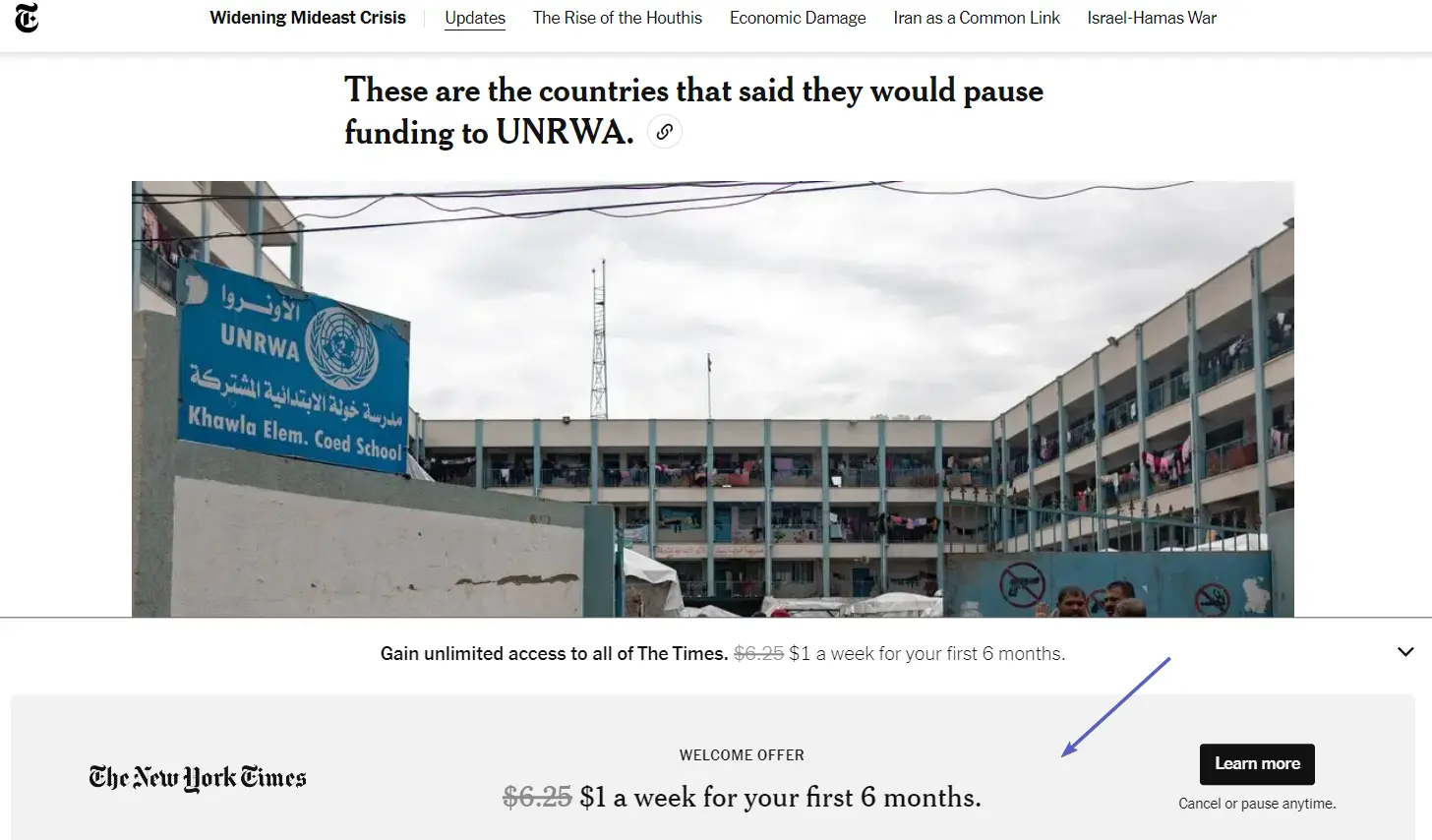
The NYT uses a causal machine learning model called the Dynamic Meter to set personalized meter limits and make the paywall more intelligent.
Source: Open.NYTimes
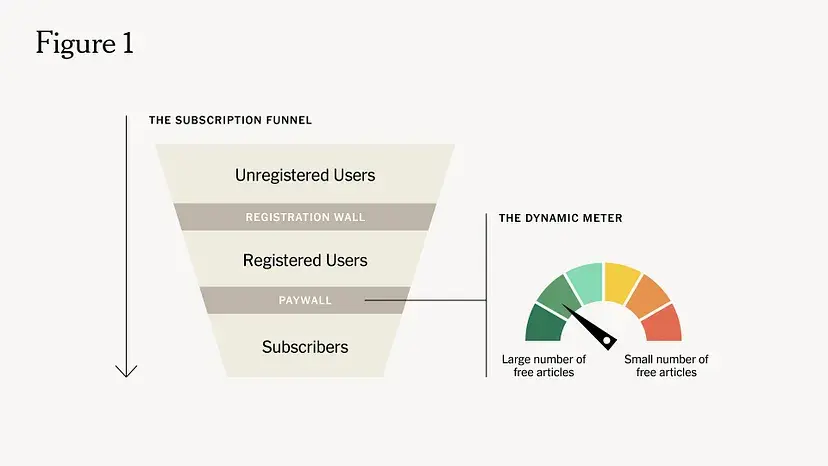
According to the 2022 annual report of The New York Times, having more content with registration with a new model has been a great asset to acquisition efforts, increasing conversion rates by over 40%.
Based on Serpstat data, The New York Times leads 13 other paywall sites in visibility in search results, approximate organic traffic, and keywords in the top 100.
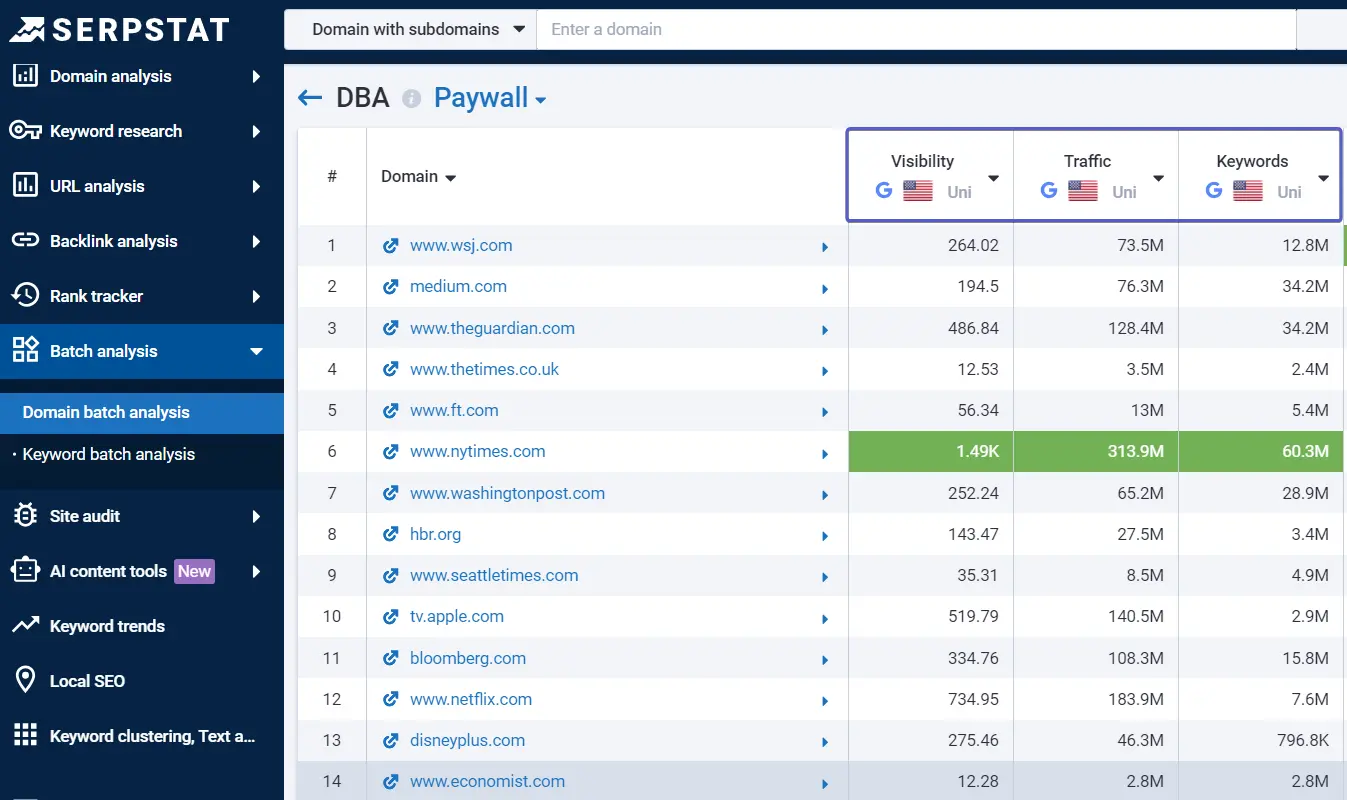
Paywall sites analysis using Serpstat Batch Analysis
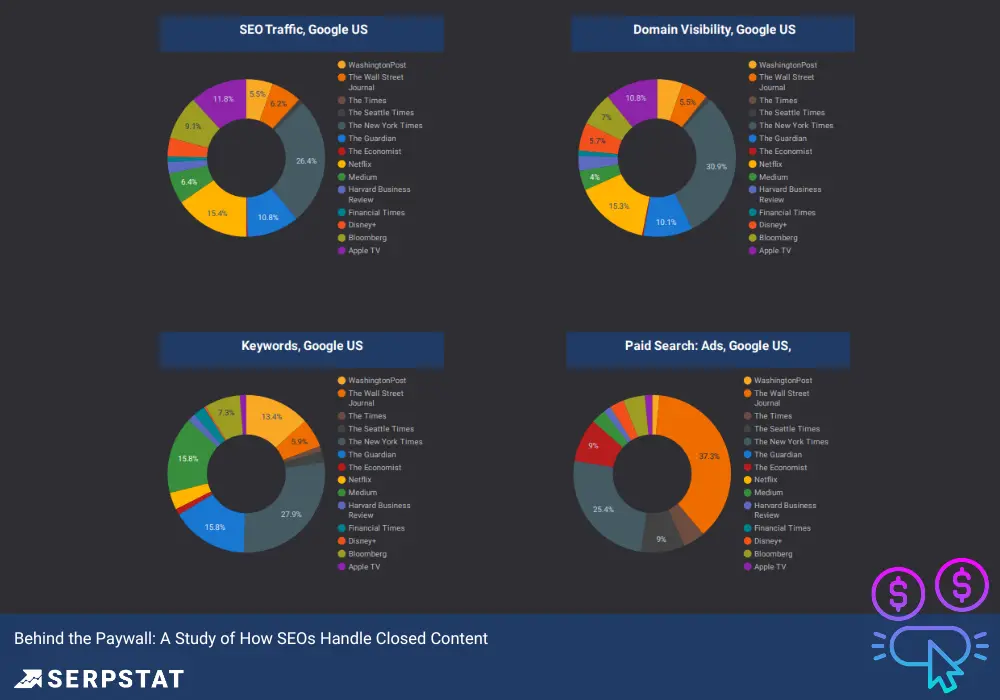
Hard paywall
The previous methods are called “soft” paywalls, allowing limited access to content. In contrast, a “hard” paywall completely restricts access to online content, requiring payment or subscription for any viewing. Readers only see a few paragraphs before being asked to subscribe.
Examples of websites using hard paywalls include The Wall Street Journal and the Financial Times.
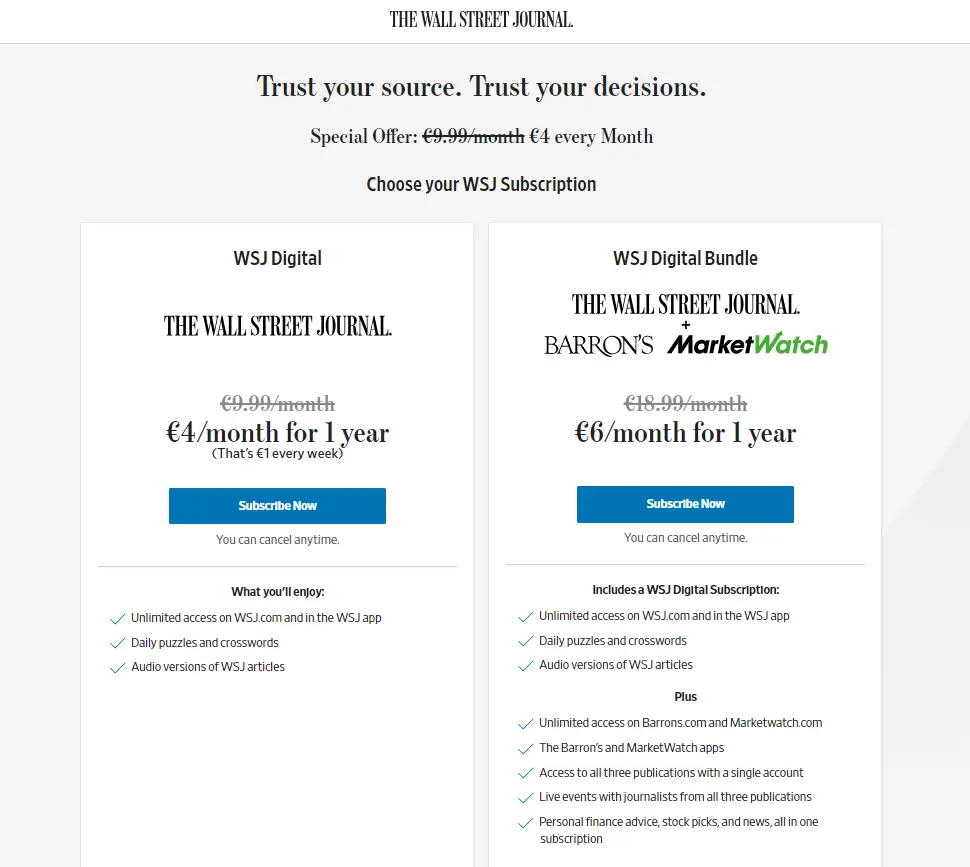
While effective for publishers with an industry audience and premium content, hard paywalls can limit exposure, reduce website traffic, and deter potential subscribers unfamiliar with the content’s value.
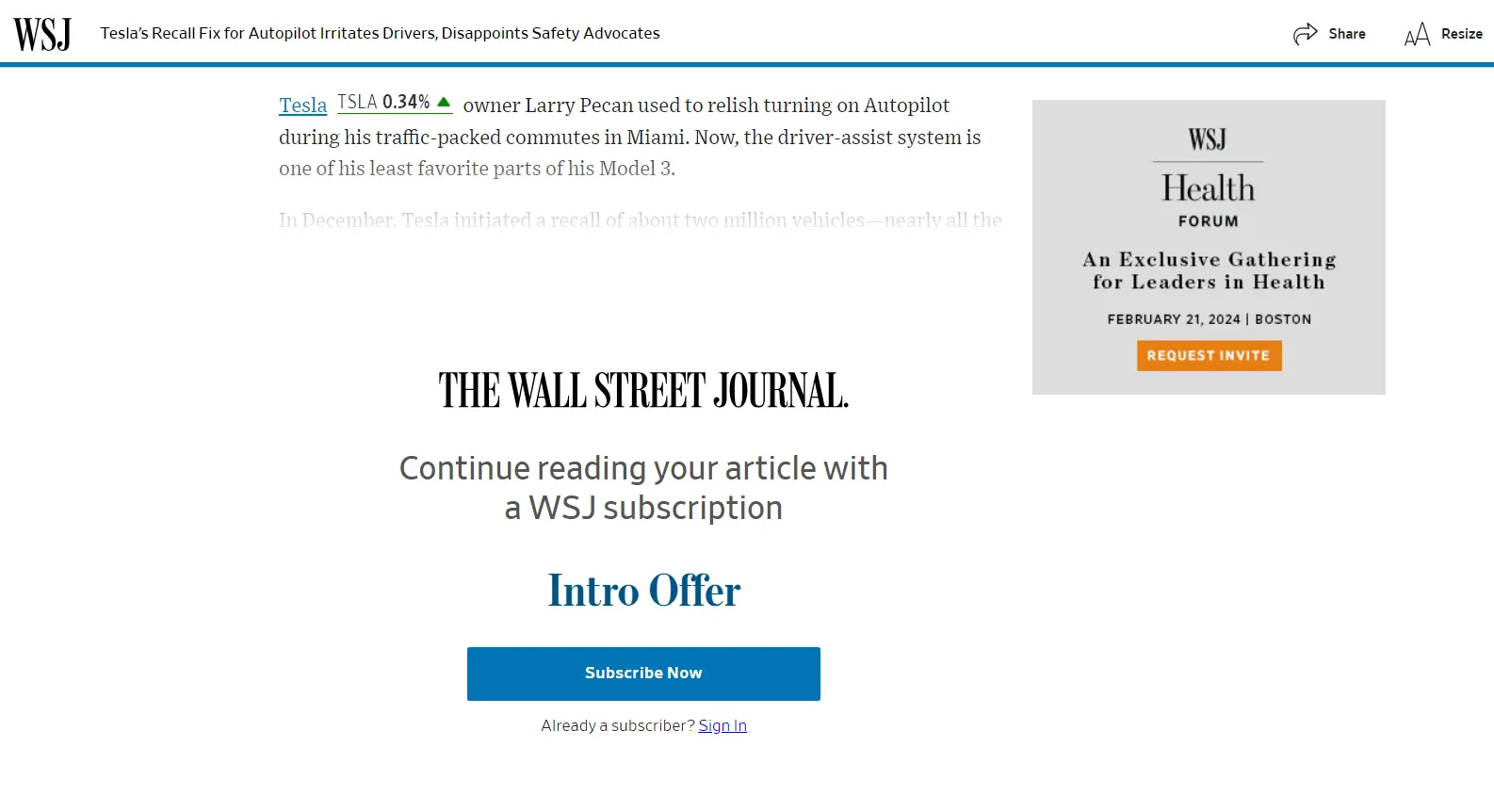
Despite some drawbacks, top-tier websites still employ hard paywalls. Still, the best option largely depends on the purpose of your content.
Why Put Your Content Behind a Paywall?
If your goal is to drive more visitors to your website and acquire additional backlinks, employing a gating strategy may be counterproductive to these objectives. Conversely, consider some form of content gating if you aim to increase your subscribers or generate leads.
Setting a paywall strategy involves considering various factors:
- Pricing. It should reflect the value of the content behind the paywall. Game theory and sensitivity to different price points need to be considered.
- Product range. Determine how to unbundle products from total subscriptions. For example, mobile products can be offered separately while including them in digital subscriptions.
- Industry and audience size. In less competitive markets or with smaller audiences, being strategic about what content to offer for free is essential.
- Brand heritage. Established brands can be more confident in walling content due to the trust in their brand.
- Customer service. Paid content should come with a certain level of service and functionality.
Creating a successful paywall strategy requires a trial-and-error approach and the willingness and resources to experiment with digital content to see what truly resonates with readers.
Will a Paywall Damage SEO Performance?
Usually, a paywall does not harm SEO if set up correctly. However, due to improperly implemented paid access, a site’s content may not be scanned or indexed properly. Moreover, Google might mistakenly interpret the paywall as cloaking—a “black hat” SEO technique, where the information presented to users and search engines is significantly different.
Paywall sites employ various methods to block access to their content, depending on the paywall type. Common techniques include:
- Cookie/Local storage tracking. Tracks the number of free articles accessed and displays a paywall message upon reaching the limit. Typical for metered paywalls.
- JavaScript/CSS overlays. Hides or blurs content, requiring users to sign in or subscribe for full access. Typical for soft or freemium paywalls like Medium.
- Server-side authentication/encryption. Ensures content delivery only to users with valid subscriptions or payments. Common in hard or dynamic paywalls like The Wall Street Journal.
There are more details in this table:
Source: stateofdigitalpublishing.com
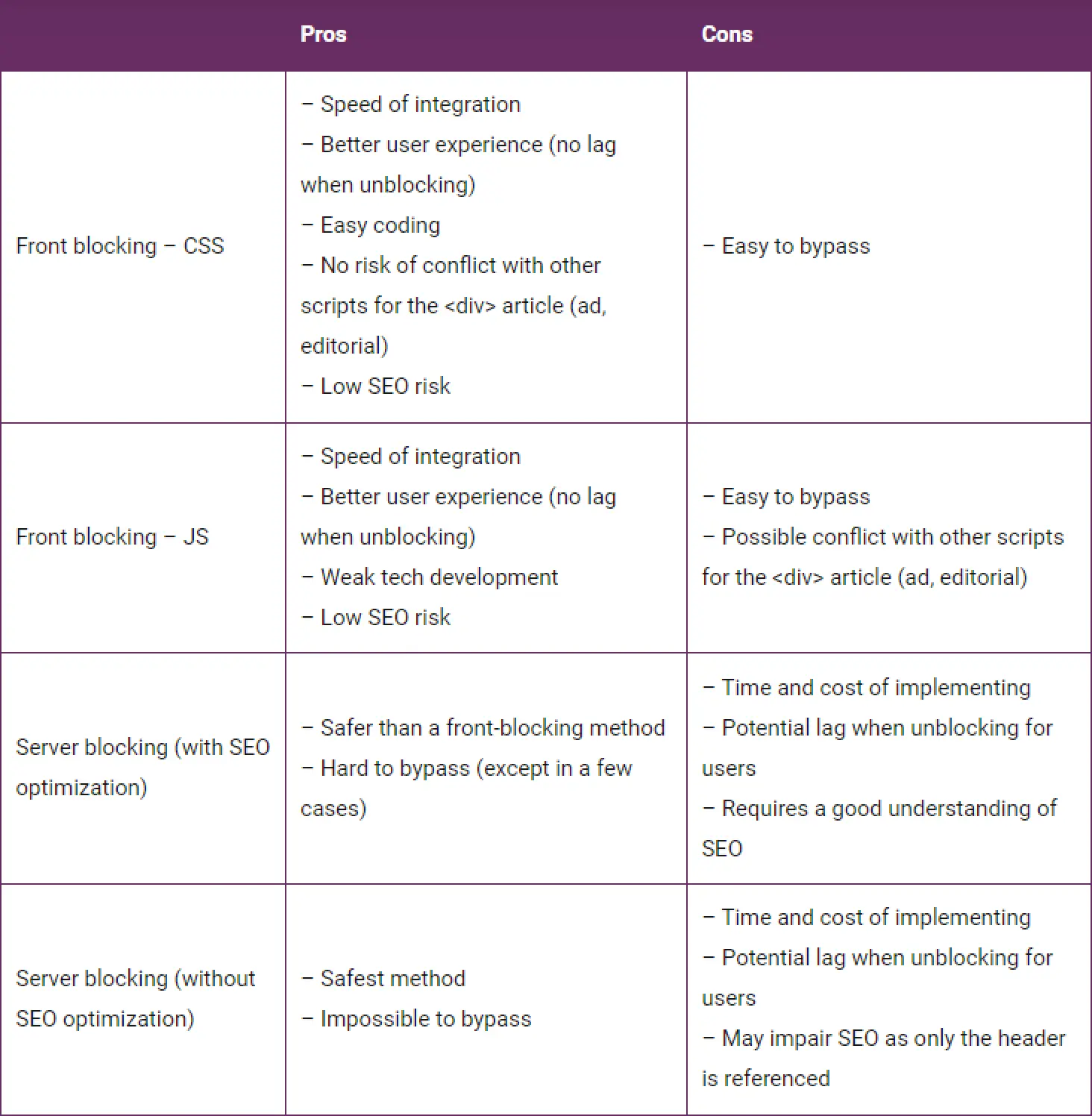
In March 2017, Google introduced its Fred algorithm update. It aimed to reward websites with good user experience and demote those with thin, ad-heavy, low-quality content. Many of the affected websites were affiliate or paywall sites. Google Fred is one of many ongoing algorithm updates by Google aimed at improving its ranking factors and signals.
The key is to allow Google to see beyond the paywall and get a full view of the article’s content, sections, links, etc. Our analysis also shows that focusing on aspects like referring and external domains and redirecting links is still valuable for paywall websites.
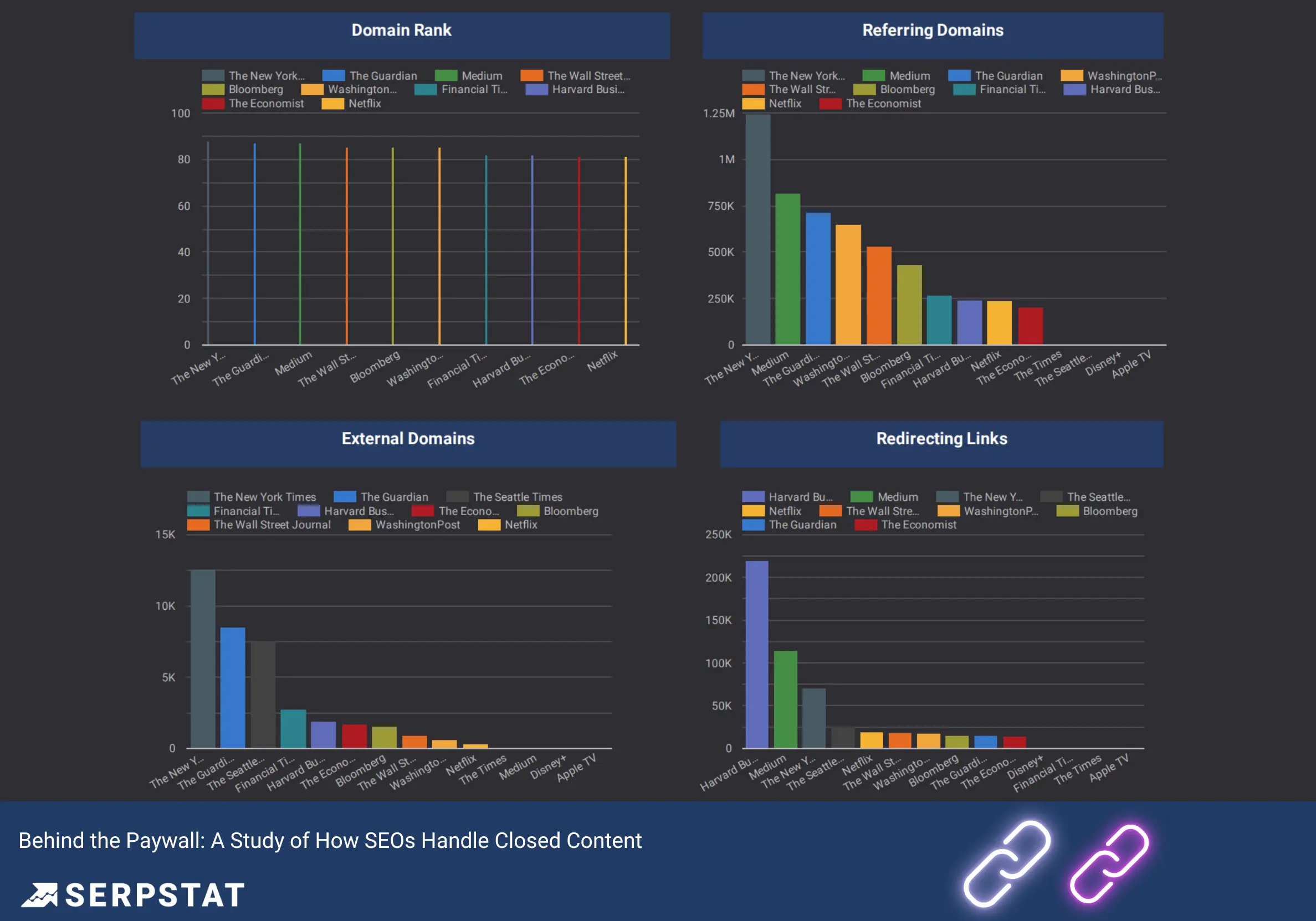
Certain domains might show unique patterns. For instance, if a site like Netflix, traditionally not viewed as a typical paywall site for written content, has many referring domains, it indicates a diversified strategy in its off-page SEO.
High numbers of referring and external domains suggest that these sites continue to benefit from a robust backlink profile. This is crucial for SEO as it contributes to domain authority and better search engine rankings.
Let’s review how to address some additional aspects of paywall impact on SEO performance:
- Search intent & content quality. Google values the search intent behind keywords. Paywalled content, often rich in information and unique insights, can meet specific informational needs, enhancing SEO performance.
- Optimizing for specific keywords. Focusing on particular informational keywords, rather than broad search terms, can better align paywalled content with user searches.
- Use of structured data. Implementing structured data helps paywalled content appear in rich snippets, increasing SERP visibility. This includes a main keyword headline, a concise summary, key facts, and details about paywall content.
- Reduced reliance on ads. Paywall sites often have fewer ads, improving user experience and loading speed and aligning with Google’s preference for user-friendly sites. This can lead to better engagement, loyalty, fewer pogo-sticking, and potentially higher SEO rankings. Paywall sites with excessive or misleading ads risk Google penalties for poor user experience, negatively impacting SEO. They may also experience lower click-through rates and higher bounce rates due to reader aversion to ads.
How to Limit Paywall’s Impact on SEO
Google and Bing are increasingly adapting to paywalled content, but some key rules remain. To limit a paywall’s impact on SEO, follow these rules:
1.Experiment with sampling. Test different amounts of content accessible without a paywall to find a balance between user experience and conversion opportunities. Monthly metering is recommended for its flexibility.
2.Manage paywall exposure. Limit it to avoid diminishing user satisfaction. A threshold of 10% is advisable.
3.Use Lead-ins. Display a portion of the article above the paywall to engage readers and add value.
4.Offer free content. Providing a certain number of free articles per month (typically 6-10) can be effective for news sites.

7.Use ‘Noarchive’ meta tag. Prevent full articles from being accessed via Google’s cache by using this meta tag.
Conclusion
A high-quality article, blog, video, or podcast requires significant effort and investment. This content typically addresses more in-depth research needs rather than basic information. The most common methods of covering these costs are digital subscriptions. However, keeping a realistic perspective on SEO and the publishing market is important.
FAQ
Paywall sites require users to pay a fee or subscribe to access their content. Paywall sites can pose some challenges for SEO, as they may limit the visibility and accessibility of their content to search engines and users. However, there are also some benefits, such as generating more revenue, attracting more qualified leads, and enhancing the perceived value and trustworthiness of the content.
Searching “paywall” in Google yields many articles on “how to bypass paywall,” indicating significant interest in such methods. While paywall systems vary in security, no system is foolproof, but providers continuously work to prevent bypassing, which is unlikely to impact site revenue significantly.
A well-implemented paywall generally doesn’t negatively impact SEO. However, issues can arise when paywalls are improperly configured, leading to challenges in content scanning and indexing by search engines. This can be effectively addressed through technical adjustments and structured data. By ensuring that these technical aspects are correctly set up, sites can maintain their SEO performance while operating behind a paywall. Publishers should use Google Search Console (GSC), Serpstat Rank Tracker, Site Audit, and GA4 to determine and fix SEO performance issues immediately.
High-quality paywall sites focusing on unique, relevant content meeting user intent can achieve higher search rankings.
